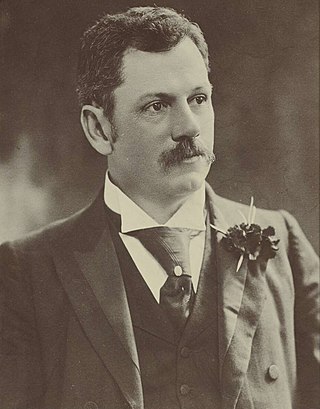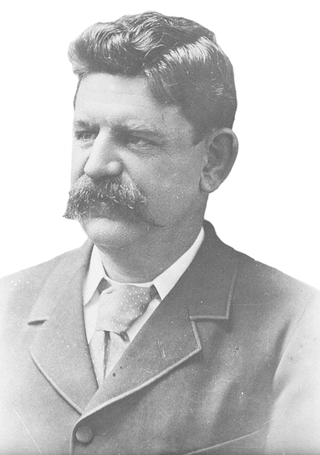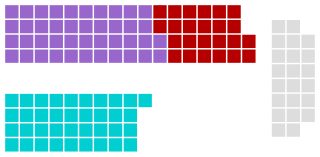Annandale was an electoral district of the Legislative Assembly in the Australian state of New South Wales, created in 1894, with the abolition of multi-member constituencies, from part of Balmain, and named after and including the Sydney suburb of Annandale. With the introduction of proportional representation, it was absorbed into the multi-member electorate of Balmain. It was recreated in 1927, but was abolished in 1950, and partly replaced by Newtown-Annandale.
Alexandria was an electoral district of the Legislative Assembly in the Australian state of New South Wales, created in 1904, partly replacing Waterloo, and named after and including the Sydney suburb of Alexandria. With the introduction of proportional representation, it was absorbed into the multi-member electorate of Botany. It was recreated in 1927, but was abolished in 1930.

Arthur Hill Griffith was a politician, teacher and patent attorney in New South Wales, Australia. He was a member of the New South Wales Legislative Assembly from 1894 until 1917 and held a number of ministerial positions in the Government of New South Wales. He was a member of the Labor Party.
Members of the New South Wales Legislative Assembly who served in the 28th parliament of New South Wales held their seats from 1927 to 1930. They were elected at the 1927 state election, and at by-elections. The Speaker was Sir Daniel Levy.</ref>
Members of the New South Wales Legislative Assembly who served in the 23rd parliament of New South Wales held their seats from 1913 to 1917. They were elected at the 1913 state election on 6 December 1913.</ref> The Speaker was Richard Meagher.
The members of the New South Wales Legislative Assembly who served in the 21st parliament of New South Wales from 1907 to 1910 were elected at the 1907 state election on 10 September 1907. The Speaker was William McCourt.</ref>
Alexandria, an electoral district of the Legislative Assembly in the Australian state of New South Wales, had two incarnations, the first from 1904 to 1920, the second from 1927 to 1930.
Annandale, an electoral district of the Legislative Assembly in the Australian state of New South Wales, had two incarnations, the first from 1894 to 1920, the second from 1927 to 1950.

The Carruthers ministry was the 32nd ministry of the New South Wales Government, and was led by the 16th Premier, Joseph Carruthers. The title of Premier was widely used to refer to the Leader of Government, but was not a formal position in the government until 1920. Instead the Premier was appointed to another portfolio, usually Colonial Secretary. In this case, Carruthers chose the portfolio of Treasurer.

The 1917 New South Wales state election was held on 24 March 1917. This election was for all of the 90 seats in the 24th New South Wales Legislative Assembly and it was conducted in single-member constituencies with a second ballot if a majority was not achieved on the first. The 23rd parliament of New South Wales was dissolved on 21 February 1917 by the Governor, Sir Gerald Strickland, on the advice of the Premier William Holman.

The 1913 New South Wales state election was held on 6 December 1913. This election was for all of the 90 seats in the 23rd New South Wales Legislative Assembly and it was conducted in single-member constituencies with a second ballot if a majority was not achieved on the first. The 22nd parliament of New South Wales was dissolved on 6 November 1913 by the Governor, Sir Gerald Strickland, on the advice of the Premier William Holman.

The 1910 New South Wales state election was held on 14 October 1910 for all of the 90 seats in the 22nd New South Wales Legislative Assembly and it was conducted in single-member constituencies with a second ballot if a majority was not achieved on the first. Both adult males and females were entitled to vote, but not Indigenous people. The 21st parliament of New South Wales was dissolved on 14 September 1910 by the Governor, Lord Chelmsford, on the advice of the Premier Charles Wade.

The 1904 New South Wales state election was held on 6 August 1904 for all of the 90 seats in the 20th New South Wales Legislative Assembly and it was conducted in single-member constituencies with a first past the post voting system. For the first time, women were entitled to vote. Both adult males and females were entitled to vote, but not Indigenous people. The 19th parliament of New South Wales was dissolved on 16 July 1904 by the Governor, Sir Harry Rawson, on the advice of the Premier, Thomas Waddell.

The 1901 New South Wales state election was held on 3 July 1901 for all of the 125 seats in the 19th New South Wales Legislative Assembly and it was conducted in single-member constituencies with a first past the post voting system. The Parliamentary Electorates Act of 1893 had conferred the right to vote on every male British subject over 21 years of age who was resident in New South Wales for a year or more. The 19th parliament of New South Wales was dissolved on 11 June 1901 by the Governor, Lord Beauchamp, on the advice of the Premier, John See.
The 1907 New South Wales state election involved 90 electoral districts returning one member each and was held on 10 September 1907.

The 1891 New South Wales colonial election was held in the then colony of New South Wales between 17 June to 3 July 1891. This election was for all of the 141 seats in the New South Wales Legislative Assembly and it was conducted in 35 single-member constituencies, 20 2-member constituencies, 10 3-member constituencies and nine 4-member constituencies, all with a first past the post system. Part 1 of the Electoral Act of 1880 set the qualification for election on "every male subject of Her Majesty of the full age of twenty-one years and absolutely free being a natural born or naturalized subject". Seven seats were uncontested. The previous parliament of New South Wales was dissolved on 6 June 1891 by the Governor, The Earl of Jersey, on the advice of the Premier, Sir Henry Parkes.
The 1907 New South Wales state election involved 90 electoral districts returning one member each. The election was conducted on the basis of a simple majority or first-past-the-post voting system.
The 1904 New South Wales state election involved 90 electoral districts returning one member each. The election was conducted on the basis of a simple majority or first-past-the-post voting system. There were two significant changes from the 1901 election, the first was that women were given the right to vote, which saw an increase in the number of enrolled voters from 345,500 in 1901, to 689,490 in 1904. The second was that as a result of the 1903 New South Wales referendum, the number of members of the Legislative Assembly was reduced from 125 to 90. The combined effect of the changes meant that the average number of enrolled voters per electorate went from 2,764, to 7,661, an increase of 277%. Leichhardt was the only district that was not substantially changed, while The Macquarie and The Murray districts retained nothing but the name.
Belmore, an electoral district of the Legislative Assembly in the Australian state of New South Wales was created in 1904 and abolished in 1920.
Surry Hills, an electoral district of the Legislative Assembly in the Australian state of New South Wales had two incarnations, from 1904 until 1920 and from 1927 until 1930.









